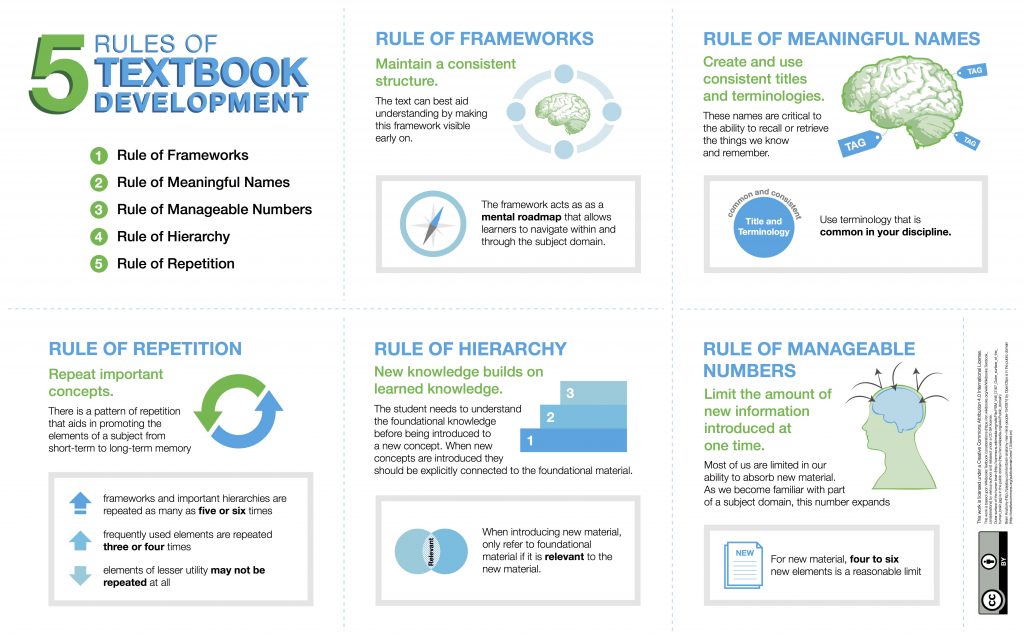Plan Your Book
15 Five Rules of Textbook Development
The below list provides five rules that help guide the development of a good textbook.[1]
1. Rule of frameworks
Memory and understanding are promoted by the use of a structure that mimics the structures we all use within our minds to store information. Before we can use or master a subject, we have to have a mental road map that allows us to navigate within and through the subject domain. The text can best aid understanding by making this framework visible early on within each section or topic. The extent to which the student understands that they are using a framework, and knows what that framework is, is important as they internalize and make use of the material presented.
2. Rule of meaningful names
Everything we know is tagged with an index or a title. These indices are critical to the ability to recall or retrieve the things we know and remember. Each concept, process, technique or fact presented should aid the student to assign a meaningful name for it in their own mental organization of the material. To be most useful, these names shouldn’t have to be relearned at higher levels of study. The names assigned by the text should be useful in that they support some future activities: communication with other practitioners, reference within the text to earlier mastered material, and conformity to the framework used for the subject. Each unique element of the subject domain should have a unique name, and each name should be used for only one element.
3. Rule of manageable numbers
When we learn from an outline, an illustration, or an example, most of us are limited in our ability to absorb new material. As we become familiar with part of a subject domain this number expands, but for new material four to six new elements is a reasonable limit. If a chapter outline contains twelve items, the student will have forgotten the outline before getting to the last item. When a text fails to support this rule, it requires even a diligent student to needlessly repeat material.
4. Rule of hierarchy
Our mental frameworks are hierarchical. Learning is aided by using the student’s ability to couple or link new material with that already mastered. When presenting new domains for hierarchical understanding, the rules for meaningful names and manageable numbers have increased importance and more limited application. A maximum of three levels of hierarchy should be presented at one time. The root should be already mastered, the current element under consideration clearly examined, and lower levels outlined only to the extent that they help the student understand the scope or importance of the current element. This area is supplemented by two more rules within this rule: those of Connectivity and Cohesion. Connectivity requires consideration of what the student likely knows at this point. The more already mastered elements that one can connect with a new element, the easier it is to retain. Cohesion requires that the characteristics of new elements as they are presented be tightly coupled.
5. Rule of repetition
Most people learn by repetition, and only a few with native genius can achieve mastery without it. There is a pattern of repetition that aids in promoting the elements of a subject from short-term to long-term memory. Implementations of this rule may mean that frameworks and important hierarchies are repeated as many as five or six times, while frequently used elements are repeated three or four times, and elements of lesser utility may not be repeated at all. The first repetition should normally occur within a day of first presentation, followed by a gradually decreasing frequency. Exercises and review sections are ideally contributing to a designed repetition pattern.

Attributions
The content in this chapter comes from Wikibooks:Textbook considerations and is used under a CC BY-SA 3.0 Licence.
Long Descriptions
5 Rules of Textbook Development long description:
- The rule of frameworks means maintain a consistent structure. The text can best aid understanding by making this framework visible early on.
- The rule of meaningful names means create and use consistent titles and terminologies. The names are critical to the ability to recall or retrieve the things we know and remember.
- The rule of manageable numbers means limit the amount of new information introduced at one time.
- Rule of hierarchy means new knowledge builds on learned knowledge. The student needs to understand the foundational knowledge before being introduced to a new concept. When new concepts are introduced the should be explicitly connected to the foundational material.
- The rule of repetition means repeat important concepts. There is a pattern of repetition that aids in promoting the elements of a subject from short-term to long-term memory.
[Return to 5 rules of textbook development image]
- "Wikibooks:Textbooks considerations," Wikibooks, https://en.wikibooks.org/wiki/Wikibooks:Textbook_considerations (accessed January 24, 2018). ↵

